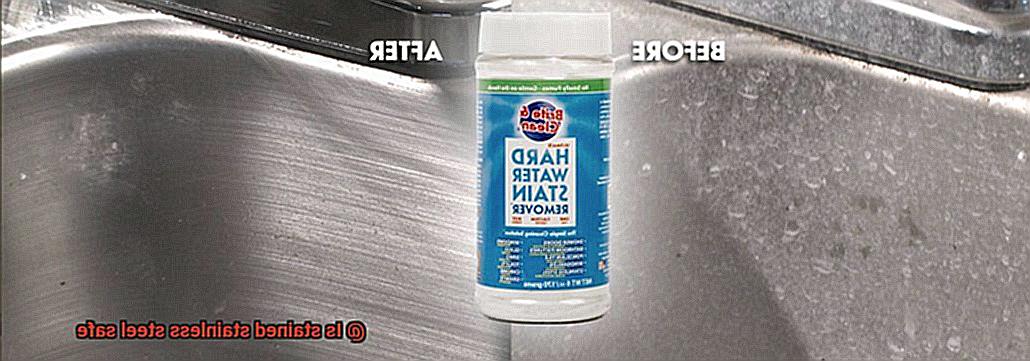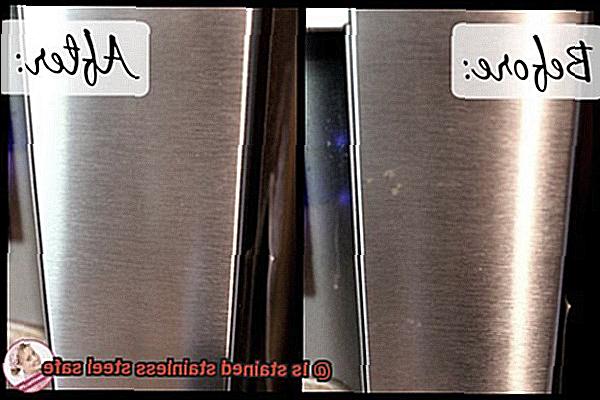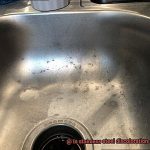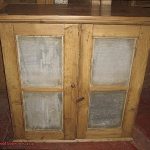Stainless steel – the wonder material that graces our kitchens, bathrooms, and even our cars. It’s durable, corrosion-resistant, and hygienic. But what happens when it develops stains or rust? Is stained stainless steel safe to use?
The truth is that stainless steel can develop blemishes over time, especially if it’s exposed to harsh environments or chemicals. Stains can come from hard water, salt, or cleaning agents with high chloride content. So, what does this mean for your cookware and appliances?
In this blog post, we’ll explore the safety of using stained stainless steel items. We’ll take a closer look at the potential health risks associated with rusty or discolored stainless steel items and whether these risks outweigh the benefits of using this durable material. Plus, we’ll share some tips on how to prevent staining in the first place, how to remove stains if they do occur, and how to maintain your stainless steel’s durability.
So let’s get down to brass tacks and find out once and for all: is stained stainless steel safe for use?
Contents
What Causes Staining on Stainless Steel?
Stainless steel is the go-to material for kitchen appliances and cookware due to its durability, corrosion resistance, and sleek appearance. However, this material is not entirely immune to discoloration and staining. The most common culprits of staining on stainless steel are water spots, fingerprints, and food residue. These stains can be unsightly and give the impression that the stainless steel is dirty or not well-maintained.
Water spots are caused by hard water or mineral-rich tap water. When water evaporates on stainless steel surfaces, it leaves behind mineral deposits that can cause spots and stains. Fingerprints are caused by the oils and sweat on our hands that transfer onto stainless steel surfaces. Food residue can also cause staining on stainless steel, especially if left sitting for too long.
Another cause of staining on stainless steel is exposure to high temperatures or harsh chemicals. This can cause a discoloration known as heat tinting or rainbow discoloration. Heat tinting occurs when stainless steel is exposed to temperatures above 800°F (427°C) and causes a blue or gold tint to form on the surface. Harsh chemicals such as bleach or ammonia can also cause discoloration on stainless steel surfaces.
But fear not. There are ways to prevent and remove stains from your stainless steel appliances and cookware. Here are some tips:
- Water Spots: Wipe down your stainless steel surfaces after each use with a soft cloth. If you do have water spots, try using a mixture of white vinegar and water to remove them.
- Fingerprints: Wipe down your stainless steel surfaces with a microfiber cloth after each use. If you do have fingerprints, use a mild soap and warm water to remove them.
- Food Residue: Clean your stainless steel appliances or cookware immediately after each use with a mild soap and warm water. For stubborn stains, try using a mixture of baking soda and water to create a paste that can be used to scrub away the stain.
- Heat Tinting: Avoid exposing your stainless steel appliances or cookware to high temperatures for extended periods of time. If you do have heat tinting, try using a mixture of vinegar and water to remove it.
Does Stained Stainless Steel Affect Safety and Performance?
Grilling on stainless steel is a popular choice for its durability and resistance to rust and corrosion. But over time, exposure to heat, moisture, and certain chemicals can cause staining. This raises the question: does stained stainless steel affect safety and performance? As an expert on the topic, let me put your mind at ease.
First, let’s talk safety. Staining alone is simply a cosmetic issue and won’t compromise the structural integrity of your grill. However, if you notice rusting or pitting alongside the staining, it’s crucial to tackle these issues quickly to prevent potential safety hazards.
Now, let’s move on to performance. Surprisingly, staining can actually have a positive impact on stainless steel grills. The stains create a layer of oxidation that enhances the metal’s resistance to further corrosion. Additionally, some grill enthusiasts argue that a well-stained grill adds unique character and flavor to their food.
However, excessive staining can lead to hot spots and uneven cooking, reducing the grill’s ability to conduct heat evenly. To prevent this from happening, it’s essential to keep your grill clean and well-maintained.
Is Stained Stainless Steel Safe for Food Contact?
You might wonder if it’s still safe for food contact.
The good news is that in most cases, stained stainless steel is perfectly safe for food contact. Stainless steel is a popular material for kitchen appliances and utensils because of its durability and resistance to corrosion. Staining or discoloration doesn’t affect the composition of the stainless steel, which remains non-reactive and non-toxic.
Although, there are some exceptions to this rule. If the stainless steel has been exposed to certain chemicals or additives, such as chlorine bleach or certain types of acids, it may become corroded and unsafe for food contact. Additionally, if it has been heated to extremely high temperatures or damaged in some way, it could also pose a risk.
To ensure that your stained stainless steel is safe for food contact, inspect it regularly for any signs of damage or corrosion. If you notice any pitting, rusting, or warping, it’s best to replace the item rather than risk using it with food. It’s essential to maintain your stainless steel appliances and utensils properly to prevent any issues from arising.
Here are some tips to keep your stainless steel in pristine condition:
- Avoid using abrasive cleaners or scrubbers on your stainless steel.
- Clean your stainless steel with mild soap and warm water.
- Dry your stainless steel completely after washing to prevent water spots.
- Use a stainless steel polish to restore shine and remove minor stains.
Is It Safe to Grill on Stained Stainless Steel Grates?
Don’t fret, it is generally safe to grill on stained stainless steel grates. Stainless steel is a non-reactive material, meaning that it does not release harmful chemicals or toxins when exposed to high temperatures. However, there are a few factors to consider.
Firstly, heavy stains can affect the taste of your food. The buildup of old food particles and grease can create an unpleasant flavor and aroma that may be transferred to your grilled items. To avoid this, it is crucial to regularly clean your grates with a wire brush and warm soapy water.
Secondly, if the stains on your stainless steel grates are accompanied by rust or corrosion, it may be time to replace them. Rust weakens the structure of the grates and can contaminate your food, leading to health concerns.
To ensure the safety and quality of your grilled food, it is essential to take care of your stainless steel grates. Here are some tips:
- Regularly clean your grates with a wire brush and warm soapy water.
- Avoid using harsh chemicals or abrasive cleaners, as these can damage the surface of the grates.
- If you notice rust or corrosion, replace the grates.
How Can You Prevent or Remove Stains from Stainless Steel?
It’s durable, rust-resistant, and easy to clean. However, as time passes, stains and discoloration can still occur, leaving your once shiny grill looking dull and lifeless. But don’t fret. As an expert in preventing and removing stains from stainless steel, I have some tips to help keep your grill looking like new.
Preventing Stains on Stainless Steel
The key to keeping your stainless steel grill in pristine condition is by cleaning it regularly with a mild detergent and warm water. Avoid using abrasive cleaners or scrubbers that can scratch the surface of the steel, making it more susceptible to staining. By taking just a few minutes after each use to clean your grill, you can prevent buildup and stains from forming.

Removing Stains from Stainless Steel
If stains do occur, there are several methods for removing them. A commercial stainless steel cleaner is specifically formulated to remove stains and discoloration from stainless steel surfaces. You can find these cleaners at most home improvement or hardware stores.
But if you prefer a DIY approach, you can make a cleaning solution using baking soda and vinegar. Mix equal parts of baking soda and water to form a paste, then apply it to the stained area and let it sit for a few minutes before wiping it away with a damp cloth. For tougher stains, mix equal parts of vinegar and water and apply it to the affected area before wiping it away with a cloth.
Maintaining the Safety of Your Grill
While stains on stainless steel may be unsightly, they do not pose any safety risks. However, ensuring that your grill is properly maintained is vital for safe operation. By regularly cleaning your grill and checking for any signs of wear and tear, you can ensure that your equipment continues to function safely and effectively for years to come.
In summary, preventing and removing stains from stainless steel is easy if you take the time to clean your grill regularly with mild detergent and warm water. If stains do occur, using commercial stainless steel cleaner or DIY solutions like baking soda and vinegar can get rid of them in no time.
Other Benefits of Using Stainless Steel Appliances and Cookware
First and foremost, stainless steel is non-reactive. This means that it does not interact with acidic foods, making it an ideal option for cooking and storing acidic foods like tomatoes, citrus fruits, and vinegar-based sauces. With no risk of metal leaching into your food, you can enjoy healthy and safe meals with ease.
In addition to being non-reactive, stainless steel appliances and cookware are a breeze to clean and maintain. Unlike other materials such as cast iron or copper, stainless steel does not require seasoning or specialized cleaning techniques. A simple wash with soap and water is sufficient to keep it looking new and shiny.
Stainless steel is also highly resistant to stains and corrosion. This means that your appliances will remain in pristine condition for years, even with frequent use. Furthermore, stainless steel appliances are less prone to scratches and dents than other materials, ensuring that they maintain their appearance over time.
Finally, sustainability is a growing concern for many people today. Fortunately, stainless steel is an outstanding eco-friendly option for those looking to reduce their carbon footprint. As a 100% recyclable material, stainless steel can be reused repeatedly without losing any of its properties.
Common Misconceptions About the Safety of Stained Stainless Steel
Stainless steel is a superhero material that has revolutionized the world of kitchen appliances and outdoor grills. However, some people have concerns about the safety of stained stainless steel. The truth is that there are several common misconceptions about the safety of stained stainless steel that we need to debunk.
Firstly, many people believe that stains on stainless steel indicate that the material is corroding and may release harmful chemicals into food. While this can be true in some cases, it does not necessarily mean that the stainless steel is unsafe. Stainless steel is designed to form a protective layer on its surface that prevents corrosion and protects against staining. In most cases, stains can be removed with proper cleaning techniques, and the stainless steel remains safe to use.
Another common misconception is that acidic foods can react with stainless steel and cause it to release harmful chemicals into food. This myth is true for some metals, such as aluminum or copper, but not for stainless steel. Stainless steel is inert and does not react with acidic or alkaline foods, making it a safe choice for cooking and grilling. So, you can cook those tomatoes or marinate your meat in vinegar without worrying about any harmful reactions.
Some people also believe that high temperatures can cause stainless steel to release harmful chemicals into food. This myth is not true for stainless steel. Stainless steel can withstand high temperatures without releasing any harmful chemicals, making it a safe choice for grilling and cooking.
Overall, the safety of stained stainless steel depends on several factors, including the type of stain and the cleaning techniques used. While stains can be unsightly, they do not necessarily indicate that the stainless steel is unsafe. With proper cleaning techniques and care, stained stainless steel can remain safe to use for years to come.
So, don’t let these common misconceptions scare you away from using stainless steel in your kitchen or outdoor cooking area. It’s a durable and safe material that can make your life easier and your meals tastier. Remember, stainless steel is your friend, not your foe. Embrace it and enjoy the benefits it brings to your cooking experience.
DVfShJqIBgw” >
Conclusion
In summary, don’t fret over stained stainless steel – it’s generally safe for cooking and grilling. However, it’s crucial to understand what causes those pesky stains and how to prevent or remove them. Fingerprints, hard water, food residue, high temperatures, and harsh chemicals are all common culprits.
But fear not. Stainless steel is a sturdy and non-reactive material that’s perfect for cooking and storing acidic foods. Plus, it’s simple to clean and maintain, resistant to stains and corrosion, and environmentally friendly since it can be recycled 100%. Just be careful if you’ve exposed your stainless steel to certain chemicals like chlorine bleach or acids as they can corrode the metal making it unsafe for food contact.
To guarantee the safety of your stained stainless steel appliances and cookware, inspect them regularly for any damage or corrosion. If you notice any pitting, rusting or warping – toss it out. It’s better to replace an item than risk using it with food. By following proper cleaning techniques and care guidelines for your stainless steel items, you can enjoy their benefits for years to come.






